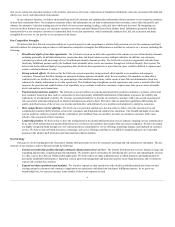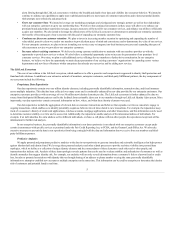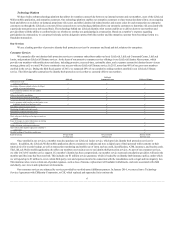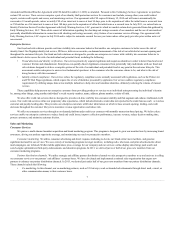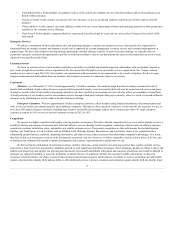LifeLock 2013 Annual Report Download - page 17
Download and view the complete annual report
Please find page 17 of the 2013 LifeLock annual report below. You can navigate through the pages in the report by either clicking on the pages listed below, or by using the keyword search tool below to find specific information within the annual report.
•effectiveness and cost-efficiency of customer acquisition;
•customer satisfaction;
•price;
•quality and reliability of customer service; and
•accurate identification of appropriate target markets for our business.
Any failure by us to compete successfully in any one of these or similar areas may reduce the demand for our services and the robustness of the
LifeLock ecosystem, as well as adversely affect our business, growth, reputation, revenue, and market share. Moreover, new competitors, alliances among
our competitors, or new service introductions by our competitors may emerge and potentially adversely affect our business and prospects.
Our services depend extensively upon continued access to and receipt of data from external sources, including data received from customers and
fulfillment partners. Our data providers could stop providing data, provide untimely data, or increase the costs for their data for a variety of reasons,
including a perception that our systems are insecure as a result of a data security breach, budgetary constraints, a desire to generate additional revenue, or for
competitive reasons. In addition, upon the termination of the contracts we have with certain of our enterprise customers, we are required to remove from our
repositories the data contributed by and through those customers. We could also become subject to legislative, regulatory, or judicial restrictions or mandates
on the collection, disclosure, or use of such data, in particular if such data is not collected by our providers in a way that allows us to legally use the data. If
we were to lose access to a substantial number of data sources or certain key data sources or certain data already in the LifeLock ecosystem, or if our access or
use were restricted or became less economical or desirable, our ability to provide our services and the efficacy and attractiveness of the LifeLock ecosystem
could be negatively affected, and this would adversely affect us from a competitive standpoint. This would also adversely affect our business, operating
results, and financial condition. We may not be successful in maintaining our relationships with these external data source providers and may not be able to
continue to obtain data from them on acceptable terms or at all. Furthermore, we cannot provide assurance that we will be able to obtain data from alternative or
additional sources if our current sources become unavailable.
The introduction of new services by competitors, the emergence of new industry standards, or the development of new technologies could render our
existing or future services less desirable or obsolete. In addition, professional thieves continue to develop more sophisticated and creative method s to steal
personal and financial information as consumers and enterprises today become increasingly interconnected and engage in a large number of daily activities that
involve personal or financial information. Consequently, our financial performance and growth depends upon our ability to enhance and improve our existing
services, develop and successfully introduce new services that generate customer interest, and sell our services in new markets. As our existing services
mature, encouraging customers to purchase enhancements or upgrades becomes more challenging unless new service offerings provide features and
functionality that have meaningful incremental value. To achieve market acceptance for our services, we must effectively anticipate and offer services that meet
changing customer demands in a timely manner. Customers may require features and capabilities that our current services lack. In addition, any new markets
in which we attempt to sell our services, including new industries, countries, or regions, may not be receptive to our service offerings. If we fail to enhance our
existing services in a timely and cost-effective manner, successfully develop and introduce new services, or sell our services in new markets, our ability to
retain our existing or attract new customers and our ability to create or increase demand for our services could be harmed, which would have an adverse effect
on our business, operating results, and financial condition.
We will be required to make significant investments in developing new services. We also will be subject to all of the risks inherent in the development of
new services, including unanticipated technical or other development problems, which could result in material delays in the launch and acceptance of the
services or significantly increased costs. In some cases, we may expend a significant amount of resources and management attention on service offerings that
do not ultimately succeed in their markets. Because new service offerings are inherently risky, they may not be successful and may harm our operating results
and financial condition.
The number of people who access services through devices other than personal computers, including mobile phones, smart phones, handheld
computers, tablets, and other mobile devices, has increased dramatically in recent years and is projected to continue to increase. We have limited experience to
date in developing services for users of these alternative devices, and versions of our services developed for these devices may not be attractive to
customers. In December 2013, in connection with our acquisition of Lemon, we launched LifeLock Wallet, our mobile wallet application. The success of our
mobile wallet application is unproven, and we have prioritized the quality of user experience with our mobile application over short-term monetization. Despite
the expected
14


